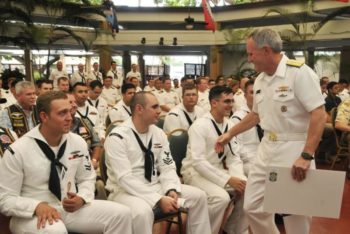
The U.S. Navy has introduced new measures aimed at avoiding a repeat of two deadly crashes in the Asia Pacific region involving its warships and commercial vessels following a review of its practices, the Seventh Fleet commander said on Monday.
Vice Admiral Phillip Sawyer’s comments come after a U.S. guided-missile destroyer was slightly damaged at the weekend when a Japanese tug drifted into it during a towing exercise off central Japan, the latest incident in the Pacific this year involving ships from the fleet.
The U.S. Navy announced a series of reforms this month aimed at restoring basic naval skills and alertness at sea after a review of deadly collisions in the Asia-Pacific region showed sailors were under-trained and over-worked.
Two of the incidents – collisions with commercial vessels involving guided-missile destroyers, the Fitzgerald in June off Japan and then the John S. McCain in August as it approached Singapore – have left a total of 17 sailors dead.
The crashes were caused by preventable errors by the sailors on board the ships, Navy investigations showed.
Speaking to reporters on the sidelines of an international fleet review in the Thai seaside town of Pattaya, Sawyer said the Navy made “circadian rhythm” sleep guidelines a requirement and a new group, the Naval Surface Group Western Pacific, has been training officers at the fleet’s headquarters in Yokosuka, south of Tokyo, Japan.
“This is a team that is now in Yokosuka and they’re charged with doing the man, train, equip aspect of our operations with surface ships,” Sawyer told reporters.
“The second thing we have done is Automatic Identification System and that’s a system onboard ships that puts out signal and it tells whoever is receiving that signal the course, speed and identification of the ship,” he said.
“The third thing is that we are working on the circadian rhythm onboard the ships” to make the sailors more alert.
Sawyer took command of the U.S. force in August after the Navy removed the fleet’s previous commander, Vice Admiral Joseph Aucoin, following a series of collisions.
The U.S. Seventh Fleet operates in the largest of the U.S. Navy’s numbered fleets. It oversees about 70-80 ships and submarines at any given time in the region.
The fleet operates over an area of 124 million square km from bases in Japan, South Korea and Singapore.